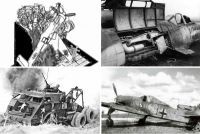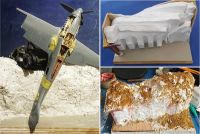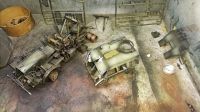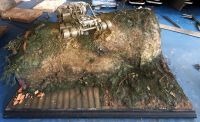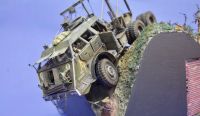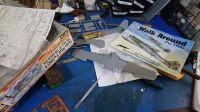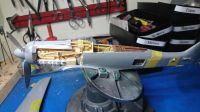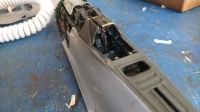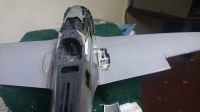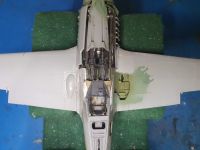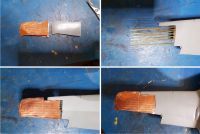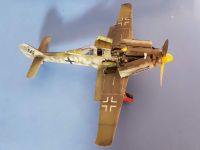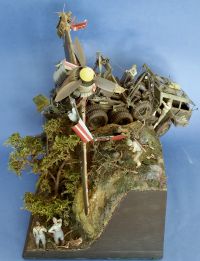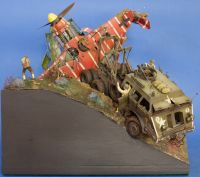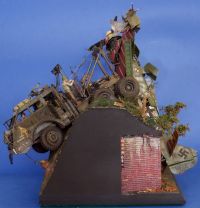Dora and The Dragon, Germany 1945, The Dismantling of JV 44
By Suresh Nathan
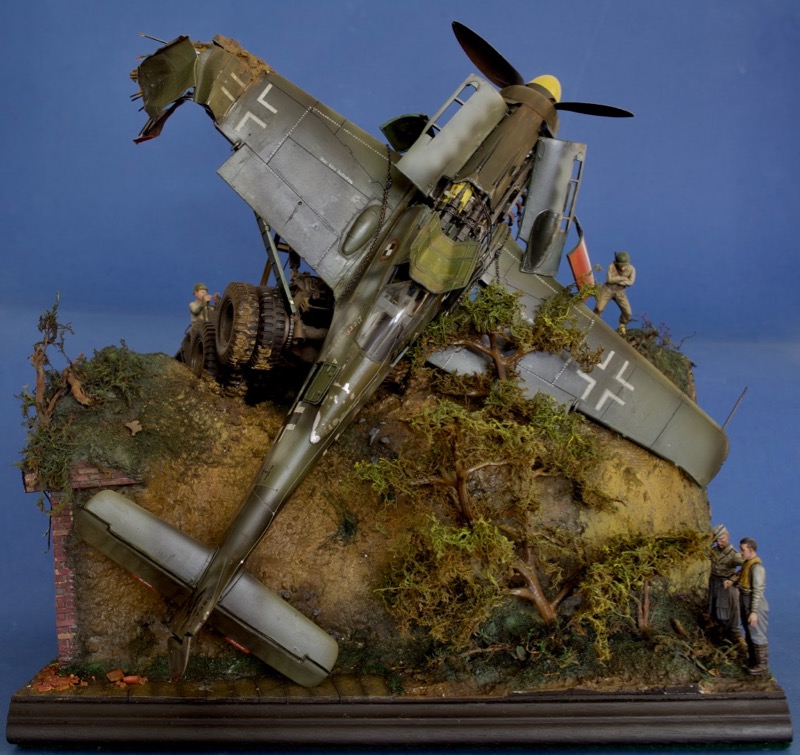
Introduction
Jagdverband 44 (JV 44) was a German air unit during World War II. The commander of JV 44 was General Adolf Galland, the former General der Jagdflieger (General of Fighter pilots) who had recently been sacked from his staff post by Hermann Göring for criticizing the operational policies, strategic doctrine, and tactics mandated by the Luftwaffe High Command. Galland was charged with setting up a small Me 262 unit to demonstrate the capabilities of the jet fighter. JV 44 comprised a core of experienced pilots chosen from Galland's former staff or recruited from units which had been disbanded or were being re-equipped. JV 44 performed well during its brief history, achieving a 4-to-1 kill ratio. However, it had relatively few operational jet planes available for any single sortie and was repeatedly forced to relocate due to the approach of Allied ground forces. Its complement included 50 pilots and 25 airplanes. It required a small group of Fw 190D-9s to operate as take-off and landing defence for the Messerschmitt Me 262 jet fighter. The Fw 190D-9s were unique in having red and white stripe undersurfaces for friendly recognition. There were probably only 5 of them attached to JV 44 in what was the unit's Platzschutzschwarm (Airfield Defence Flight). The unit had a macabre sense of humor and each aircraft had an amusing "dark humor" slogan on it. "Red 1", a Fw 190D-9 carried the slogan "Verkaafts mei Gwand 'I foahr in Himmel" ("Sell my clothes, I'm going to heaven") flown by Staffel Kapitaen Sachsenberg. He had racked 104 kills but these were all prior to Red 1.
Diorama
I like to show ground elements interacting with aircraft. This usually takes the form of maintenance or attack scenarios. The biggest problem with these sorts of dioramas is space and I’m always figuring out ways to tighten the composition over the smallest footprint. In this case, I chose to build upwards. It took me a while to figure out how to showcase the stunning red and white underside of the Papagei Staffel. With that as a pre-requisite I began to mock everything up around the Dora. Having the oversized M25 off the base throws a lot of imbalance into the composition. This was not uncommon with the M25 though. I doubt if a Diamond T could do this. I used expanded packing styrene as the rough core and formed the structure around it. In the corner you’ll see the remnants of a brick wall supposed to be the entrance of an underground bunker. It’s actually Tamiya’s old brick wall set, which literally is the only use for it I’ve ever found. The wooden walkway and all the rest of it was scratchbuilt. I've had instances in the past where aircraft models fall off and shatter and I'm constantly paranoid about it. I added a tree to effectively pin the model to the base. In addition, the plane is chained to the winch, which in turn is held together with magnets.
Model
The truck is the M26 Knuckley or (with the trailer) the M25 Dragon Wagon. For this piece a Diamond T fitted with a crane might have been a better fit. You can see M26’s functioning as general tows for everything from LCM’s to Saturn rockets so it’s a bit of an overkill to use one for the simple task of dragging a plane carcass. Nevertheless, for me, the title Dora (Fw 190D-9) and the Dragon (M26 Knuckley) was enough justification to feature it. The model is the Tamiya 1/35 kit. It is a challenging kit to build in the sheer number of parts but it goes together easily enough. It was critical to have it nicely housed in the mud and this involved repeated rounds of carving the base and blending groundwork around the model.
The Fw 190D-9 is the old Hasegawa 1/32 Special Version with the old wing and re-tooled fuselage. There are enough reviews out there and everyone knows that clearly if you’re going to build a Dora it shouldn’t be this one! Nevertheless, I bought it many years ago and I had the Jerry Rutman engine set and Verlinden cockpit set for it and so that’s what I used. The special version has white metal propeller blades and undercarriage and this proved useful as the entire model is suspended on one leg. The wings are the old Fw 190A-4 from Hasegawa with closed wing wells so all of that had to be modified. Nevertheless because this was going to be a salvage scene, I decided to cut off the wing and open up panels - in a strange way the inaccuracies of the kit made it less daunting to do that. The stabilizers would be removed too – the kit version is a coarse fabric structure which is inaccurate. The port wing was to sustain some serious crumpling at the end of the build. I built a new section out of brass and aluminium foil. It's not perfect but it's going to be crushed anyway. I also formed groundwork around this area to show how it was “dragged through the mud”. The Dora has flush rivets on the top and pan heads below. So in some sense the rivets were helpful as they were sanded down to scale and panels rescribed. I did some work in the wing gun bay and wheel wells. All of this was scratchbuilt. The wheel well is open and exposes the rear of the mighty Jumo engine. The Rutman castings were a little rough but salvageable. They were more accurate than the Verlinden offerings and where they met I elected to use the Rutman details. The rest was built from scratch. There was a lot of filler needed. Wiring and hoses are accurately depicted from references. The port side wing tip shows an actual red light dangling on its wires (for fun).
Trying to combine the Rutman and Verlinden sets was harder than expected. Verlinden provided the wrong dials (1/24?) and I used the kit decals instead. The Verlinden hood wouldn't fit the Rutman bulkhead and it had to be split. I did some weathering and detailing with cables and hoses. The chains go together with magnets so it can be disassembled for transport. Also I cut off and repositioned the rudder and stabilizers to show the effects of gravity.
The figures were from various sources. Adolf Galland is from Czech Masters and HJ Marseille from Aires (who could look like anyone - yes, I know he died in 1942) who is supposed to be Sachsenberg in this diorama. The rest were kit figures repositioned and modified with old parts and resin heads from Verlinden.
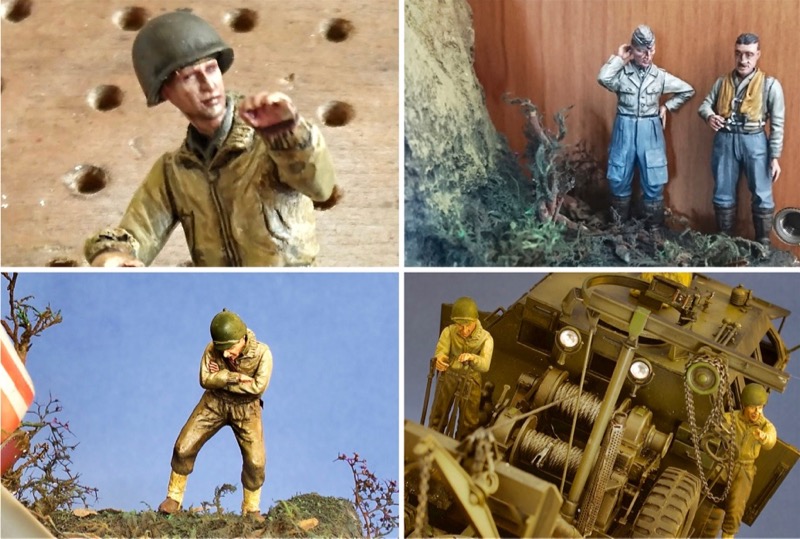
Painting
The model was base painted in Humbrol Enamels, varnished with Future-Tamiya Flat acrylic, weathered with turpenoids and drybrushed sparingly. I used oil washes for weathering and drop filters for color variation.
Papagei Staffel is a fairly complex paint scheme but very satisfying. The RLM colors are a very good match from Humbrol and Squadron’s Walk Around provided the references. The markings were all from the kit but for special stencilling like the "Sell my clothes, I'm going to heaven" those were all handpainted. The rest were printed at home.
The figures were all done in Vallejo acrylic. The resin figures are clearly a lot nicer that the kit figures and I was careful not to put them side by side.
Conclusion
This was a really enjoyable diorama. There were a few artistic liberties taken obviously but the overall idea of the sheer waste of war and the ingratitude to its players is effectively stated here, I think.
As an aside I did a little light research and discovered this. The Wunderlich contract at Kingman was successful, and resulted in the ultimate recovery of significant resources:
- 46 millions pounds of aluminum
- 6 million pounds of aluminum from engines
- 5 million pounds of aluminum propellors
- 21 million pounds of steel
- 1.6 million gallons of aviation fuel
- 256,000 gallons of oil
A total of 85 reconnaissance aircraft, 615 fighters, 54 light bombers, 266 medium bombers and 4,463 heavy bombers were disposed of at Kingman. These 5,483 aircraft scrapped by Wunderlich at Kingman generated $7.5 million in gross income.
So do the math - this is only a small fraction (1/50th) of the 265000 aircraft the US (alone) produced. The rest were smelted elsewhere, used in landfills or sit in open lots. A tiny fraction were repurposed. Boggles the mind!
References
- Squadron Fw 190D Walk Around
- You can see more in-progress shots and discussions on this project in the forums.
© Suresh Nathan 2018
This article was published on Sunday, September 30 2018; Last modified on Sunday, September 30 2018

